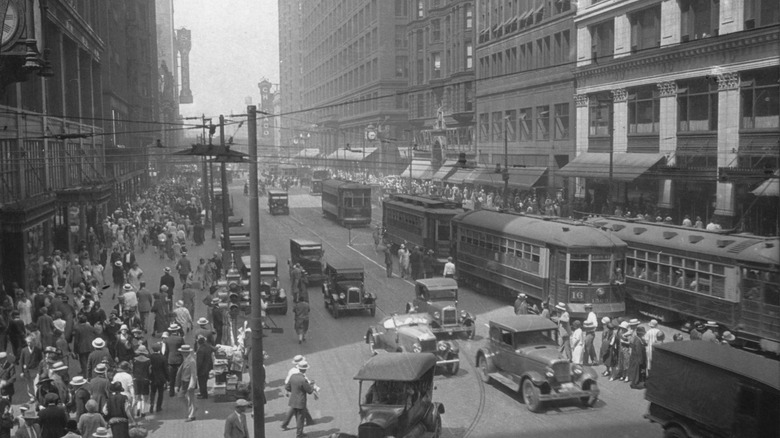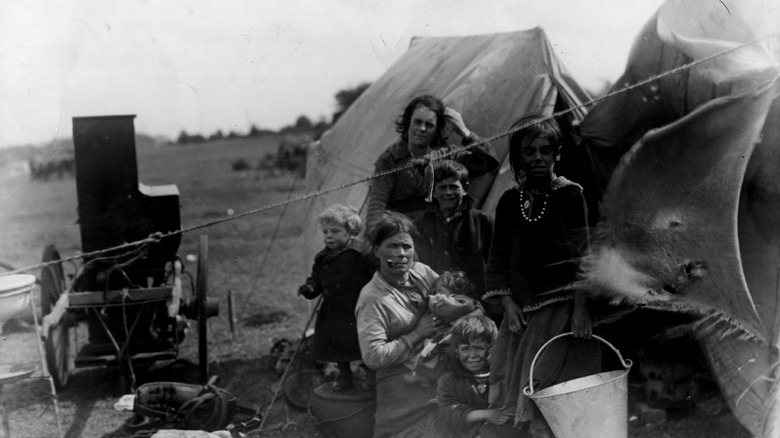The Bizarre Case Of Elsie Paroubek's Kidnapping
The city of Chicago is no stranger to sordid tales of crime. There's the story of H.H. Holmes — believed to be America's first serial killer — and his "murder castle," built near the 1893 World's Columbian Exposition held in the city's Jackson Park, the organized crime that plagued parts of the city in the 1920s and 1930s, the killing of 8 nurses by Richard Speck, murders committed by serial killer John Wayne Gacy, and the Tylenol poisonings that terrified not just the city, but the entire nation.
With so many high-profile cases in the city's history, some are bound to fall through the cracks, and the disappearance of Elsie Paroubek is one of them (via Crime Museum). Paroubek was just 4 years old when she disappeared on her way to visit her aunt back in 1911. A search ensued (notably, one that yielded few if any clues) but to this day the disappearance of Elsie Paroubek remains unsolved. In the years to come, Elsie would be a major inspiration for an art project by a Chicago janitor that no one would know about until after he moved into a nursing home, per the Museum of Modern Art.
The Paroubek family
According to American Hauntings, Eliška "Elsie" Paroubek was born in 1906 to Karolína and František "Frank" Paroubek. Karolína Paroubek was born Karolína Vojáček in November 1867 in Bohemia, which is now part of the Czech Republic. František was also born in Bohemia only two years earlier in 1867. František would go to the United States when he was 15 years old but would return to Bohemia from 1882 to 1892, at which point he married Karolína.
František worked as a painter and Karolína took care of the family's many children, of which Elsie was the seventh.
According to Crime Museum, the Paroubeks had extended family in the area, because on April 8, 1911, a 5-year-old Elsie left the house to visit an aunt who lived nearby. On her way there, she ran into her 9-year-old cousin and other neighborhood kids who were watching an organ grinder, a type of street performer who plays an instrument called a barrel organ. Most of the kids followed the organ grinder, but Elsie stayed behind. That was the last time she was seen alive.
Elsie Paroubek goes missing
A few hours after Elsie left home, Karolína Paroubek walked over to make sure that she had made it over to her aunt's house safely. But once she got there, not only was Elsie not there, her aunt said she had never arrived in the first place (via American Hauntings).
Karolína knew that Elsie had a lot of friends in the neighborhood and figured that she probably decided to go visit one of them or maybe even stay over for the night. This seems completely outrageous in modern times, but considering that in the short walk to her aunt's house Elsie had encountered her cousin and a group of friends, it's not a completely irrational explanation.
When František came home from work that night, he was told that Elsie wasn't there and that she wasn't at her aunt's house. This didn't sit right with him and he contacted the police. At first, they agreed with Karolína, that she was probably at a friend's house, but when she was still nowhere to be found the next morning, the search began.
The focus shifts to Romas as tips roll in
According to American Hauntings, when police started their search they quickly received a story from a boy named John Jirowski. Jirowski told detectives that he had seen a "Gypsy" (referred to from here on as "Roma") wagon near where Elsie had last been seen. The boy said that he had seen two women in the wagon and one of them was holding a young girl.
According to the Encyclopedia of Chicago, the Roma began settling in the Chicago area in the 1880s. They follow their own religious and legal code called Romania.
This information interested detectives because not only was there a Roma camp not far from Paroubek's neighborhood, but a similar case had unfolded several years earlier. An issue of the Kingston Daily Freeman from December 13, 1907, has an article about Lillian Wulff, another young Chicago girl who had been allegedly kidnapped but managed to escape.
Police also received a report that a young girl who fit Elsie's description had been seen in an Italian neighborhood. The tip alleged that this girl had been seen with an organ grinder.
The search comes to a tragic end
Thousands of people joined the search for Elsie Paroubek, hoping to find the young girl alive, but, unfortunately, that isn't what happened.
According to Crime Museum, on May 9, 1911, an electrical engineer named George T. Scully noticed a body floating in a drainage canal and called the police. The Paroubeks were brought in to positively identify the body. It was Elsie.
She had been missing for just over a month and had apparently been dead for some time, as the condition of her body made it difficult for the medical examiner to determine a cause of death. All they could surmise was that violence had been a factor in her death.
Elsie's funeral took place on May 12, 1911, and was attended by an estimated 3,000 people. Sadly, tragedy would continue to strike the Paroubek family as František died two years to the day after Elsie's funeral. Karolína died in 1927, and all three of them were buried together in Chicago's Bohemian National Cemetary.
The case has never been solved, but there's a strange postscript in which Elsie Paroubek lives on through an artist's work.
Elsie Paroubek in "The Realms of the Unreal"
Henry Darger was a custodian who had lived in Chicago's Wicker Pak neighborhood in the same rented room for six decades until he moved into a nursing home in 1972. Upon leaving the room, his landlord made a shocking discovery. Darger was a self-taught artist and in the room, he left behind a 5,000-page autobiography, several hundred pieces of art, and a 15,000-page novel.
The novel, which is known "In The Realms of the Unreal" — at least, that's the short title — is notoriously complicated, but a simplified synopsis is that it's about an army of child slaves who go to war against their oppressive adult masters, with all of this taking place on another planet (via Find A Grave).
Darger created artwork to accompany his novel and he did this by clipping out photos of missing children and bringing them into the functional world he was creating. This includes Elsie Paroubek, whose appearance in collages represents the novel's character, Annie Aronberg."
Darger's work was only displayed after his death, but since then it has appeared In New York City's Museum of Modern Art.





